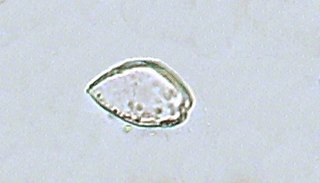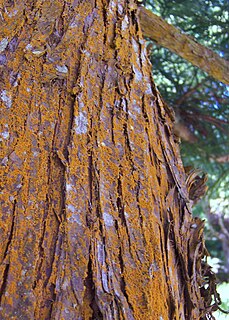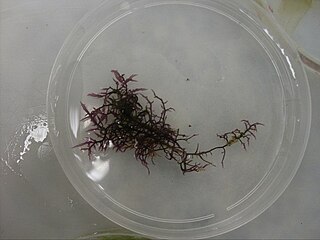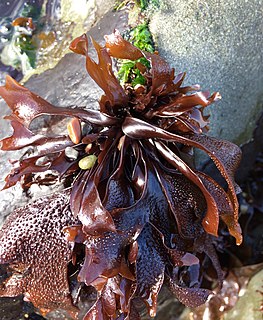
The Prorocentrales are a small order of dinoflagellates. They are distinguished by having their two flagella inserted apically, rather than ventrally as in other groups. One flagellum extends forward and the other circles its base, and there are no flagellar grooves. This arrangement is called desmokont, in contrast to the dinokont arrangement found in other groups. Accordingly, the Prorocentrales may be called desmoflagellates, and in some classifications were treated as a separate class Desmophyceae.

Fucus is a genus of brown algae found in the intertidal zones of rocky seashores almost throughout the world.

AlgaeBase is a global species database of information on all groups of algae, as well as one group of flowering plants, the sea-grasses.
In taxonomy, Desmochloris is a genus of green algae, specifically of the Chlorocystidaceae.

Trentepohlia is a genus of filamentous chlorophyte green algae in the family Trentepohliaceae, living free on terrestrial supports such as tree trunks and wet rocks or symbiotically in lichens. The filaments of Trentepohlia have a strong orange colour caused by the presence of large quantities of carotenoid pigments which mask the green of the chlorophyll.
The Mesostigmatophyceae are a class of basal green algae found in freshwater originally containing two species in a single genus, Mesostigma. Now, a clade containing Chlorokybus and Spirotaenia has been added.. The Mesostigmatophyceae are either placed as sister to all other green algae, or more conventionally as sister to all Streptophyta.
Pyrenomonas is a genus of cryptomonad.

Chaetophora elegans is the type species in the algae genus Chaetophora.
Klebsormidium is a genus of filamentous charophyte green algae comprising 20 species. The name was proposed in 1972 to resolve confusion in application and status of Hormidium. It occurs mostly in soil and on moist substrates, nevertheless, aquatic and one marine species are also known. Many Klebsormidium-species are able to synthesize substances for UV protection, the so-called mycosporine-like amino acids. The draft genome sequence of Klebsormidium flaccidum was published in 2014.
Martensia is a genus of red algae, containing the following species:

Chondracanthus is a red algae genus in the family Gigartinaceae. The name Chondracanthus is from χόνδρος} meaning 'cartilage' and ακανϑα meaning 'spine or thorn,' together meaning 'with cartilaginous spines.' This refers to the rubbery papillae on the surface of the blades containing the reproductive structures.

Rivularia is a genus of cyanobacteria of the family Rivulariaceae.
Cyanonephron elegans is a freshwater species of cyanobacteria in the family Synechococcaceae. It is described in the Netherlands, Siberia, Russia and Queensland, Australia.

Mastocarpus papillatus, sometimes called Turkish washcloth, black tar spot, or grapestone is a species of red algae in the family Phyllophoraceae. It is sometimes confused with the distantly related Turkish towel which is of a similar texture but larger. The specific epithet papillatus is due to the nipple-like projections on the female gametophyte which can give the texture of a terrycloth washcloth found at a Turkish bath.

Chondracanthus exasperatus, commonly called Turkish towel, is a species of seaweed in the family Gigartinaceae. The specific epithet exasperatus refers to the bumpy texture of the blades. This texture also leads to the common name which evokes the luxurious feel of a towel from a Turkish bath. The rough, papillae-strewn blade surface even makes it difficult to measure the temperature using infrared thermometers.

Bangiaceae is a family of red algae in the order Bangiales. It contains laver, used to make laverbread, and the species used to make nori as well as other edible seaweeds.

Michael Dominic Richard Guiry, is an Irish botanist, who specialises in phycology (algae). See for example the articles. He is the founder and director of the algal database, AlgaeBase.










